Discovering that your beloved canine companion has a torn anterior cruciate ligament (ACL), or more accurately, a cranial cruciate ligament (CCL) in dogs, can be a distressing experience for any pet owner. The immediate question that often arises is: Can A Torn Acl In A Dog Heal Itself? While the prospect of natural healing without invasive procedures is appealing, the reality is complex and depends on several factors, including the severity of the tear. It’s true that some dogs can recover from an ACL injury through conservative management, utilizing alternatives to surgery such as orthopedic braces and specific supplements. However, understanding the nuances of these injuries and the available treatment paths is crucial, always under the guidance of a licensed veterinarian.
Navigating the options for your dog’s recovery, from initial diagnosis to long-term rehabilitation, requires careful consideration of what’s best for your furry friend’s health and well-being. This guide will explore the possibilities of natural healing, the limitations, and the various interventions that can lead your dog back to a pain-free, active life. Proper care for your dog’s overall health, including preventative measures, can significantly contribute to their resilience against injuries and other ailments. For instance, maintaining good skin health can prevent common issues like how to heal hot spots on dogs which might otherwise add to their discomfort.
Understanding Your Dog’s Cruciate Ligament (CCL)
In humans, the knee joint contains the anterior cruciate ligament (ACL), a crucial connective tissue. For our canine companions, the equivalent structure is called the cranial cruciate ligament (CCL). A CCL tear in dogs is one of the most prevalent orthopedic injuries they face, impacting their ability to walk, run, and play normally. Unlike acute traumas often seen in human athletes, canine CCL tears frequently develop gradually due to chronic degeneration and repetitive stress, though sudden ruptures can also occur. The knee, or stifle joint, relies on the CCL for stability, preventing the tibia (shin bone) from sliding forward relative to the femur (thigh bone). When this ligament is compromised, the knee becomes unstable, leading to pain and lameness.
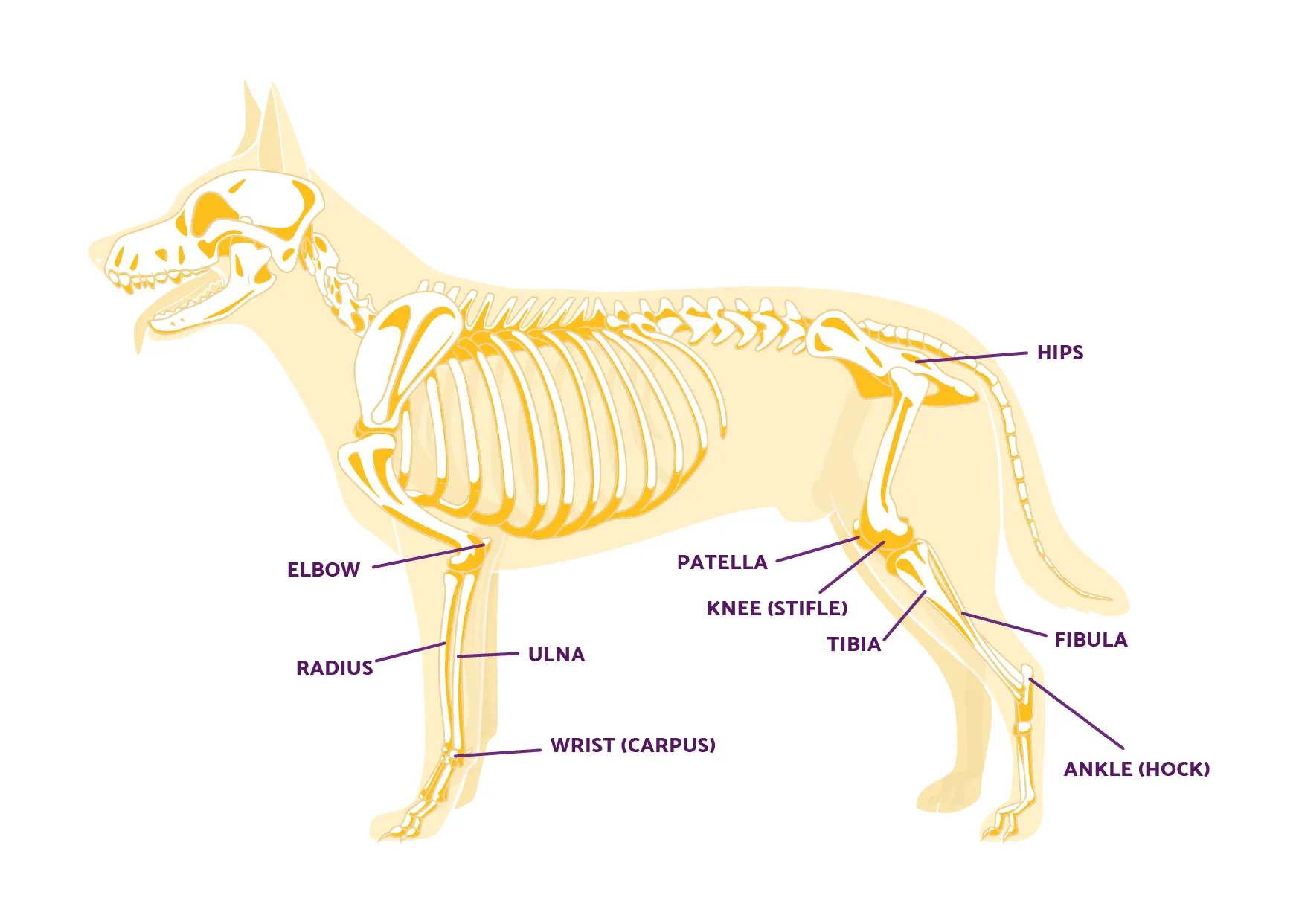 Anatomy diagram of a dog's leg showing bones and joints, highlighting the knee area
Anatomy diagram of a dog's leg showing bones and joints, highlighting the knee area
A thorough understanding of dog leg and knee anatomy is vital for appreciating the complexity of this injury and why spontaneous healing is often challenging.
Can a Dog’s Torn ACL Truly Heal Itself? The Reality of Natural Recovery
When facing a CCL injury, many owners hope that a torn ACL in a dog can heal itself. The answer is nuanced. For partial CCL tears, especially in smaller, less active dogs, the body may attempt to heal through fibrosis and scar tissue formation. This can lead to some degree of stability and pain reduction, allowing the dog to regain function over time with strict rest and supportive care. However, a complete rupture or a tear that continues to worsen usually requires more intervention, as the inherent instability of the joint makes natural, complete healing difficult and often leads to further joint degeneration and arthritis.
The success of conservative management for partial tears depends heavily on factors such as:
- Severity of the tear: Minor, partial tears have a better chance of scar tissue formation.
- Dog’s size and weight: Smaller dogs (under 25-30 lbs) tend to fare better with conservative treatment due to less stress on the joint.
- Activity level: Active dogs, working dogs, or those with high energy levels may struggle more with conservative approaches due to the challenge of restricting their movement for the necessary healing period.
- Age and overall health: Younger, healthier dogs may have a more robust healing response.
- Owner compliance: Strict adherence to rest protocols and rehabilitation exercises is paramount.
It is critical to manage expectations. Even if a partial tear seems to heal, the knee may remain predisposed to future injury or development of osteoarthritis due to residual instability. This is why continuous veterinary oversight is essential to monitor progress and adjust treatment plans.
Symptoms and Causes of a Canine ACL/CCL Tear
Recognizing the signs of a CCL tear early can make a significant difference in your dog’s recovery. The symptoms can vary depending on the severity and chronicity of the injury.
Common Symptoms of a Torn ACL/CCL in Dogs:
- Limping or lameness: This is often the first and most obvious sign. Your dog might hold the injured leg up or refuse to put weight on it.
- Favoring the injured leg: They might shift weight to the non-injured leg, even when standing still.
- Difficulty getting up or lying down: Stiffness and pain can make these movements challenging.
- Reluctance to jump, run, or climb stairs: Activities that put stress on the knee will be avoided.
- Abnormal sitting posture: A dog with a CCL tear may sit with the injured leg extended out to the side rather than tucked underneath.
- Swelling and inflammation: The knee joint may appear swollen to the touch.
- Muscle atrophy: Over time, the muscles in the injured leg may begin to waste away from disuse.
- Clicking sound: In some cases, a clicking or popping sound might be heard from the knee joint.
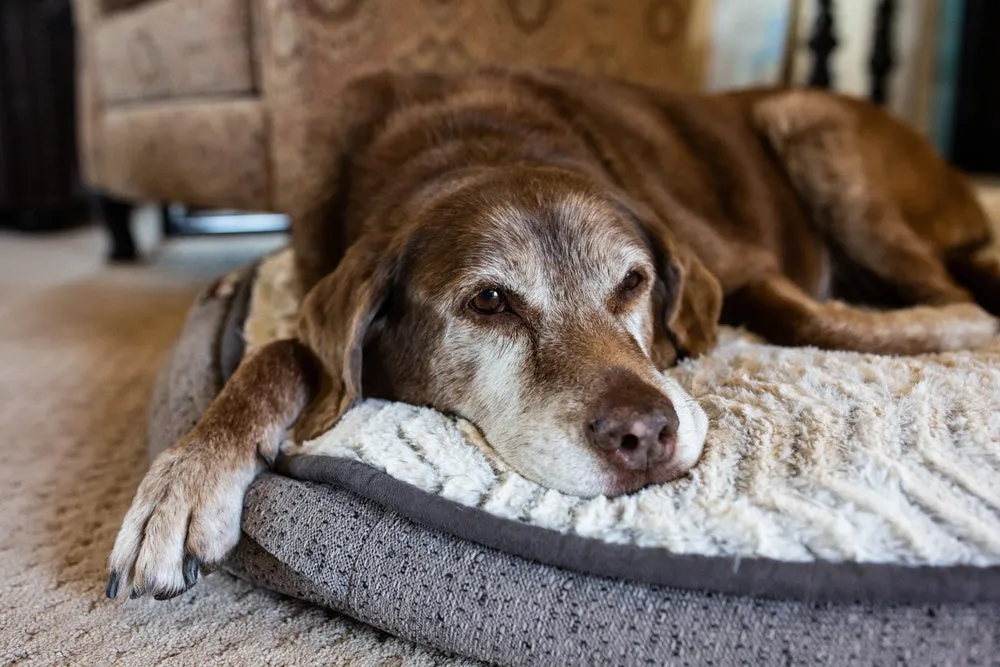 A sad dog looking down, indicating discomfort or pain, possibly from an injury
A sad dog looking down, indicating discomfort or pain, possibly from an injury
Factors Contributing to ACL/CCL Tears:
Unlike acute athletic injuries in humans, canine CCL tears often result from a combination of chronic stress and degenerative changes in the ligament.
- Lack of consistent and regular exercise: Weak muscles and ligaments are more prone to injury.
- Overweight or obesity: Excess weight places immense strain on the knee joints, accelerating degeneration.
- Overexertion: Sudden bursts of activity after periods of inactivity can overwhelm compromised ligaments.
- Age: Older dogs are more susceptible to degenerative changes in their ligaments.
- Genetics: Certain breeds, such as Labrador Retrievers, Rottweilers, Newfoundlands, Akitas, and American Staffordshire Terriers, have a higher predisposition.
- Conformation: Anatomical abnormalities in the knee joint can increase susceptibility.
- Other injuries: A CCL tear in one knee often puts additional strain on the other, leading to a tear in the opposite limb in a significant percentage of cases (up to 60%).
Beyond orthopedic injuries, general pet health is crucial. Addressing other health concerns like home remedies for dog skin allergies itching ensures your dog can focus their energy on recovery.
Conservative (Non-Surgical) Treatment Options for CCL Tears
For dogs where a torn ACL might heal itself partially, or when surgery isn’t an option, conservative management offers a range of alternatives. These approaches focus on reducing inflammation, stabilizing the joint, and promoting scar tissue formation.
- Strict Rest and Activity Restriction: This is foundational. Limiting activity to short, controlled leash walks for several weeks or months is essential to prevent further damage and allow scar tissue to develop. Crate rest might be necessary for highly active dogs.
- Orthopedic Dog Braces: A canine CCL brace, like the Ortho Dog Knee Brace, can provide external support and stability to the knee joint. These non-rigid braces help by limiting excessive flexion and extension, allowing scar tissue to form a “callus” over the tear and stabilize the knee. They are a cost-effective and less invasive alternative, particularly for partial tears or as support during rehabilitation.
 Dog with a torn ACL/CCL wearing a supportive dog knee brace
Dog with a torn ACL/CCL wearing a supportive dog knee brace - Physical Rehabilitation: A structured physical therapy program is vital for both surgical and non-surgical recoveries. It includes:
- Controlled exercises: Gentle range-of-motion exercises, passive flexion and extension.
- Hydrotherapy (swimming): Low-impact exercise that builds muscle strength without stressing the joint.
- Therapeutic massage: Improves circulation and reduces muscle stiffness.
- Balance and proprioception exercises: Helps restore normal movement patterns.
- Anti-inflammatory Medications and Pain Management: Non-steroidal anti-inflammatory drugs (NSAIDs) can help manage pain and reduce inflammation, making the dog more comfortable during the healing process.
- Joint Supplements: Supplements containing ingredients like glucosamine, chondroitin, MSM, and fish oil (omega-3 fatty acids) can support joint health, reduce inflammation, and promote cartilage integrity. Turmeric is another supplement known for its anti-inflammatory properties.
- Acupuncture: Some veterinarians offer acupuncture as a complementary therapy to help manage pain and improve circulation, potentially aiding healing.
The efficacy of these alternatives is highly individual and should always be discussed thoroughly with your veterinarian.
Surgical Interventions for Canine ACL/CCL Tears
When conservative treatments are unlikely to lead to sufficient healing, especially with complete tears or in larger, more active dogs, surgery often becomes the recommended course of action. Canine ACL surgery aims to stabilize the knee joint, reduce pain, and prevent further degradation. There are three primary orthopedic procedures:
- Lateral Suture Technique (Extracapsular Repair): This is typically the least invasive and most affordable option, costing between $1,100 – $2,500. It involves placing a strong synthetic suture (a “false ligament”) outside the joint capsule to mimic the function of the torn CCL and stabilize the knee. It’s often recommended for smaller dogs or those with partial tears.
- Tibial Plateau Leveling Osteotomy (TPLO): This is a more complex and expensive procedure, ranging from $3,000 – $6,000. TPLO involves cutting and rotating the top part of the tibia (tibial plateau) to change the angle of the joint. This eliminates the need for the CCL by making the joint stable regardless of the ligament’s presence. It is highly effective for larger and more active dogs.
 A Golden Retriever dog after surgery, recovering
A Golden Retriever dog after surgery, recovering - Tibial Tuberosity Advancement (TTA): Similar to TPLO in its goal to stabilize the knee biomechanically without relying on the CCL, TTA typically costs between $3,500 – $4,500. In this procedure, a linear cut is made along the front of the tibia, and a bone spacer is inserted to advance the tibial tuberosity forward. A metal plate then secures the bone in its new position, reducing the strain on the CCL.
Each surgical option has its own set of pros, cons, and potential risks, including infection, implant failure, and the need for extensive post-operative rehabilitation. Recovery from surgery involves strict activity restriction for 8 to 12 weeks, followed by a gradual return to activity with physical therapy. Understanding common dog health issues, such as how to address my dog has crusty scabs on his back home remedies, is part of comprehensive care for your pet’s overall well-being during recovery.
Making the Right Decision for Your Dog
Deciding whether a torn ACL in a dog can heal itself with conservative treatment or if surgery is necessary is a complex choice that requires careful consideration of various factors and, most importantly, a thorough consultation with your veterinarian. Your vet will assess the extent of the tear, your dog’s breed, age, weight, activity level, overall health, and any pre-existing conditions.
Factors to discuss with your vet:
- Diagnosis confirmation: X-rays and physical examination are crucial to confirm a CCL tear and rule out other issues.
- Tear severity: Partial tears often have more conservative options.
- Dog’s temperament: Will your dog tolerate strict rest and physical therapy?
- Financial considerations: Surgery costs, post-op care, and rehabilitation expenses vary significantly.
- Owner commitment: Both conservative and surgical paths require significant time, patience, and effort from the owner.
- Potential complications: Discuss risks associated with both surgery and non-surgical approaches.
Remember, the primary goal is to restore comfort and function for your dog. A customized treatment plan, developed with your veterinarian, is key to achieving the best possible outcome. Holistic health practices, like knowing how to heal dog ear infection at home or ensuring proper parasite control with a dog wormer and flea treatment in one tablet, also contribute to your dog’s readiness for recovery.
Rehabilitation and Long-Term Care for a Torn ACL
Regardless of whether your dog undergoes surgery or follows a conservative management plan, rehabilitation is a critical component of a successful recovery from a torn CCL. This phase helps to restore strength, range of motion, and proprioception (awareness of body position), while minimizing muscle atrophy and preventing future injuries.
Key aspects of rehabilitation:
- Pain Management: Continuing with prescribed pain medications or anti-inflammatories as needed.
- Controlled Exercise Progression: Gradually increasing activity levels under vet guidance, starting with short, slow leash walks and progressing to longer walks, gentle hills, and controlled play.
- Physical Therapy: Specific exercises to strengthen core muscles, hindquarters, and improve balance. This can include targeted stretches, balance board exercises, and therapeutic exercises.
- Weight Management: Maintaining a healthy weight is paramount to reduce stress on the knee joints and prevent re-injury, especially for the opposite limb.
- Joint Support: Continuing with joint supplements and potentially a knee brace for ongoing support, especially during high-impact activities.
- Monitoring: Regular veterinary check-ups to monitor joint health, detect any signs of arthritis, and adjust the rehabilitation plan as needed.
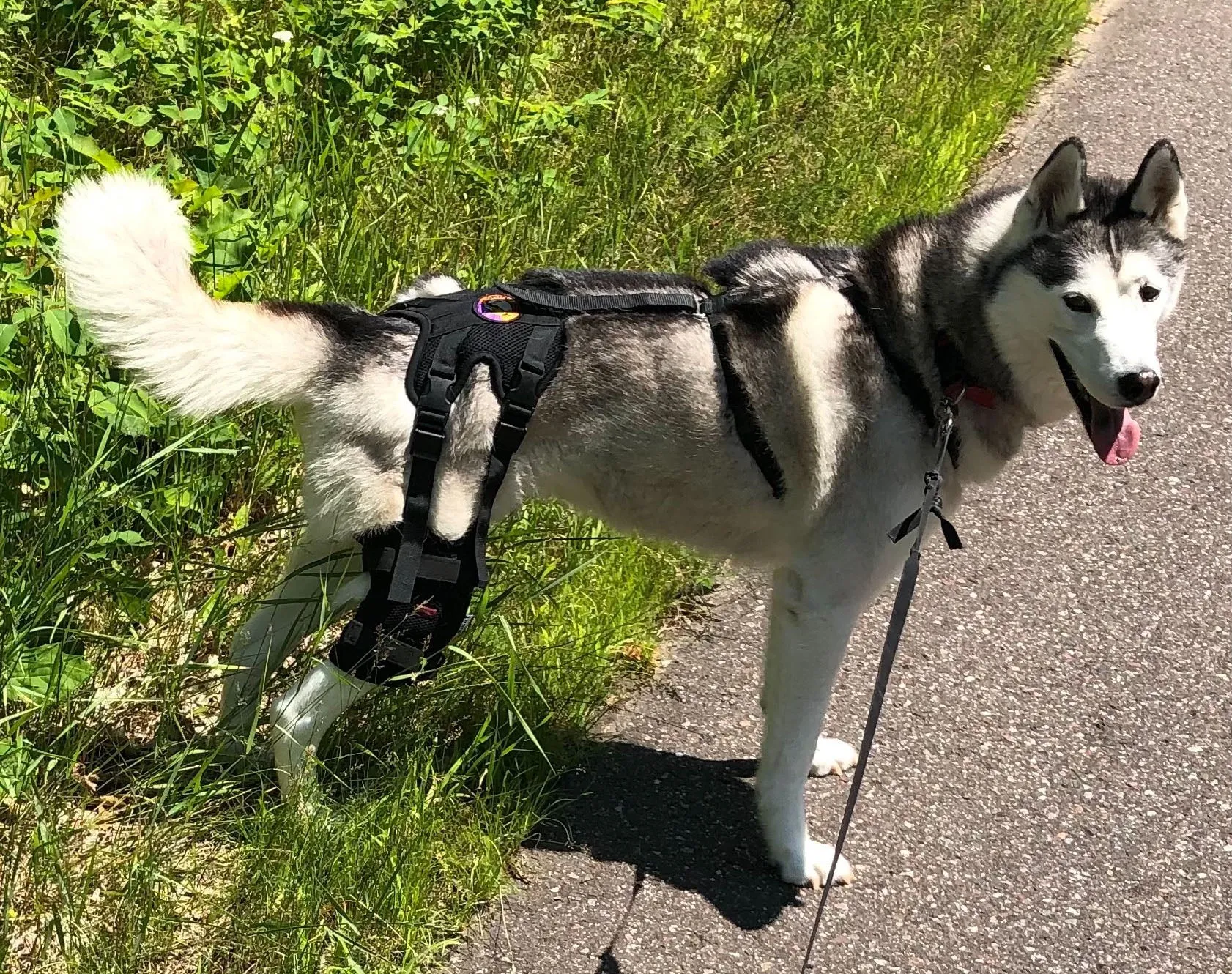 A Husky wearing a dog knee brace, offering support and stability for an ACL/CCL tear
A Husky wearing a dog knee brace, offering support and stability for an ACL/CCL tear
Long-term care involves being mindful of your dog’s activity levels, providing a balanced diet, and ensuring their living environment is safe and supportive. With dedication and consistent care, many dogs can return to a happy, active life even after a torn ACL.
Conclusion
The question of “can a torn ACL in a dog heal itself” is complex, with partial tears showing some capacity for natural recovery, particularly in smaller dogs under strict management. However, for most dogs and complete tears, significant veterinary intervention, whether conservative or surgical, is typically required to ensure proper healing and long-term stability. The journey to recovery from a CCL injury demands patience, commitment, and a proactive approach to your dog’s health. By understanding the anatomy, symptoms, causes, and available treatment options—from orthopedic braces and supplements to various surgical procedures—you can make informed decisions. Above all, partnering with a licensed veterinarian is indispensable. Their expertise will guide you in choosing the most appropriate path for your dog, ensuring they receive the best possible care to get back to enjoying pain-free playtime and a high quality of life. Always prioritize your veterinarian’s advice and continue exploring resources that support your dog’s overall well-being.

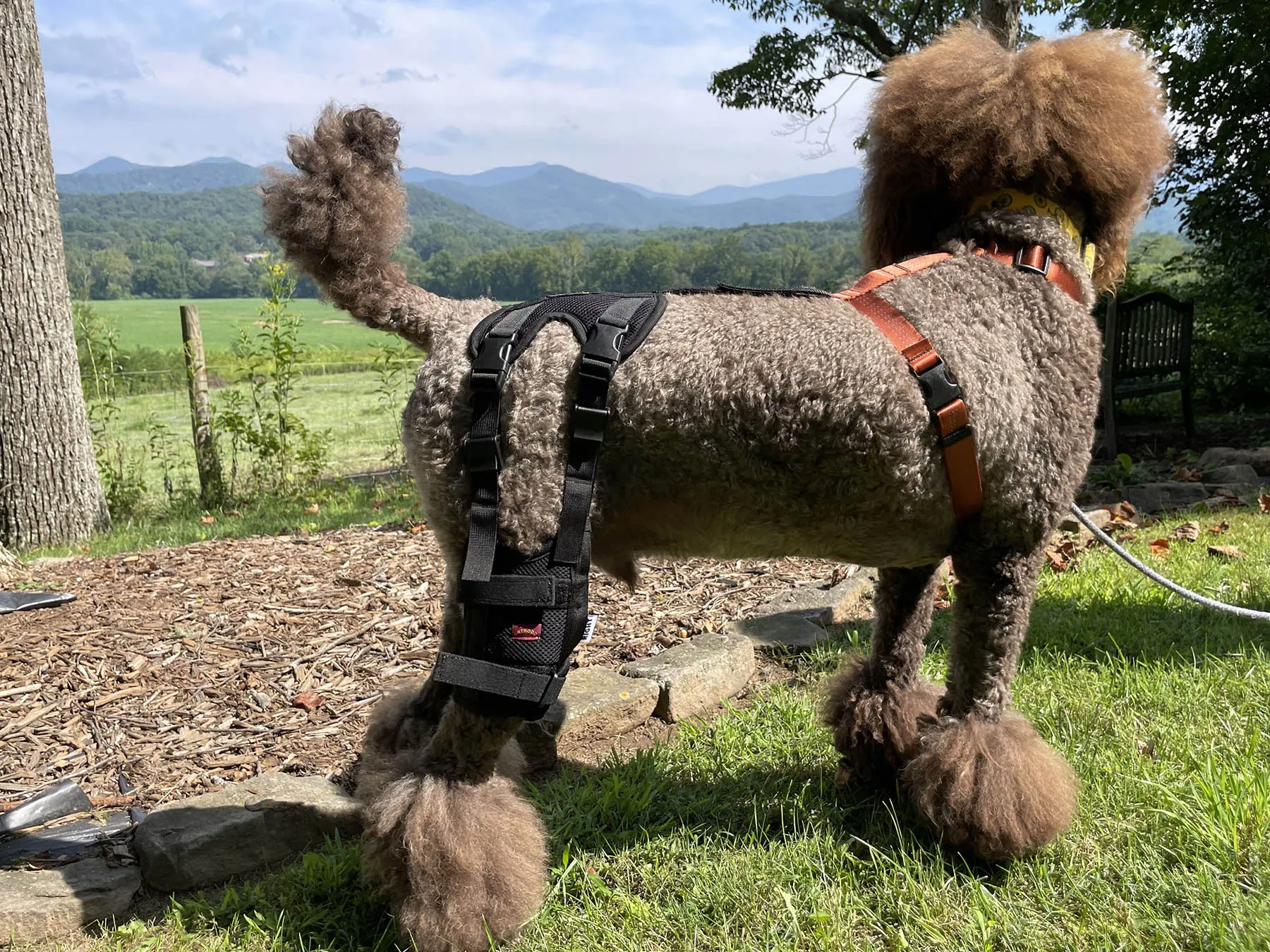 Dog with a torn ACL/CCL wearing a supportive dog knee brace
Dog with a torn ACL/CCL wearing a supportive dog knee brace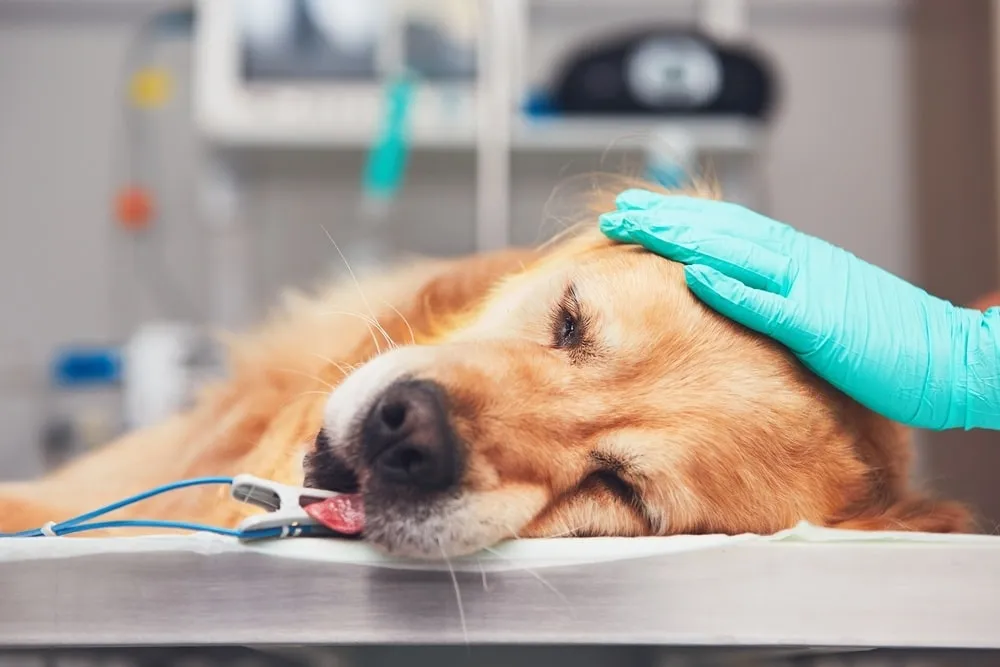 A Golden Retriever dog after surgery, recovering
A Golden Retriever dog after surgery, recovering